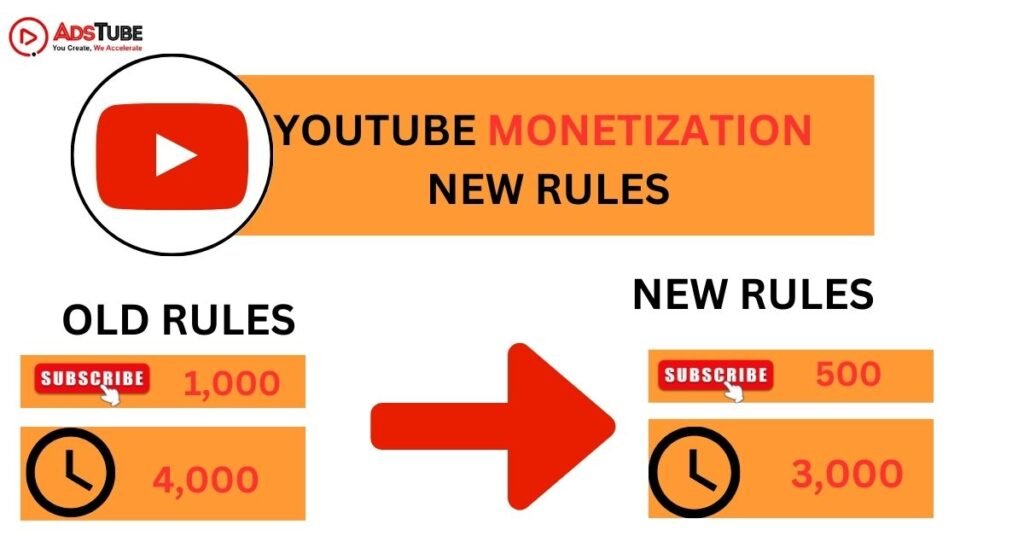In order to make it simpler for smaller content producers to monetize their channels, YouTube has released new restrictions. The new regulations, which take effect on June 14, 2023, lower the minimum watch time and subscription requirements for channels to be able to earn money.
The minimum requirements for a channel to qualify for monetization under the previous regulations were at least 1,000 subscribers and 4,000 watch hours over the previous 12 months. The new monetization rules lower the minimum number of subscribers to 500 and the viewing time required to 3,000 over the previous year, which equates to 3 million views of Shorts during the previous 90 days.
YouTube says the new rules are designed to “help more creators monetize content and support themselves and their families”. The company also says the changes will help “level the playing field for creators of all sizes”.
In addition to time demands on subscribers and viewers, YouTube is changing its budget as well. The company is updating its advertiser-related content guidelines to clarify the types of non-monetary content. This includes cases of violence, hatred, or sexual orientation.
YouTube is also updating its policy on self-promotion. Under the new rules, creators will be allowed to promote their own products and services in their videos, but they will need to be clear that they are doing so. Creators will also be prohibited from promoting other creators’ products or services without their permission.
The new YouTube monetization guidelines are a significant change for YouTube creators. The lower subscriber and watch time requirements will make it easier for smaller creators to earn money from their content, and the updated advertiser-friendly content guidelines will help to ensure that creators are aware of what types of content are not allowed to be monetized.
Here is a more detailed look at the new monetization rules:
- Subscriber and watch time requirements: Channels need to have at least 500 subscribers and 3,000 watch hours in the past year or 3 million Shorts views in the last 90 days to be eligible for monetization.
- Advertiser-friendly content guidelines: Content that is violent, hateful, or sexually suggestive is not allowed to be monetized.
- Self-promotion policy: Creators can promote their own products and services in their videos, but they must be clear that they are doing so.Creators are also prohibited from promoting other creators’ products or services without their permission.
YouTube says new funding guidelines will be phased in over the next few weeks. Creators who meet the eligibility requirements will be notified via email when they can begin monetization of their strategies.
The new YouTube monetization guidelines are a positive step for YouTube creators. The lower subscriber and watch time requirements will make it easier for smaller creators to earn money from their content, and the updated advertiser-friendly content guidelines will help to ensure that creators are aware of what types of content are not allowed to be monetized.
The United States, Canada, and the United Kingdom would be the first countries to implement the recently introduced monetization rules. These nations were selected because they have the most active YouTube communities and the most YouTube users overall. In the ensuing months, the new regulations will then be implemented in additional nations.
Here are the specific steps involved in implementing the new monetization rules:
- YouTube will notify all eligible channels of the new rules.
- Channels will have 30 days to comply with the new rules.
- Once a channel has complied with the new rules, it will be eligible to start monetizing its videos.
- In order to prevent any disturbance to the YouTube community, YouTube is applying the new monetization rules gradually. To ensure that creators are aware of the updated rules and follow them, the corporation is also collaborating with them.
- The new monetization rules are a positive step for YouTube creators. The lower subscriber and watch time requirements will make it easier for smaller creators to earn money from their content, and the updated advertiser-friendly content guidelines will help to ensure that creators are aware of what types of content are not allowed to be monetized.
Here are some of the benefits of the new monetization rules:
- More creators will be able to earn money from their content. The lower subscriber and watch time requirements will make it easier for smaller creators to earn money from their content. This will help to level the playing field for creators of all sizes.
- Creators will have more control over their content. The updated advertiser-friendly content guidelines will give creators more control over their content. This will help to ensure that creators can create the content that they want to create without fear of being demonetized.
- YouTube will be a more attractive platform for advertisers. The new monetization rules will make YouTube a more attractive platform for advertisers. This is because the new rules will help to ensure that YouTube is a safe and reliable platform for advertisers to reach their target audiences.
- Overall, the new monetization rules are a positive step for YouTube creators, advertisers, and the YouTube community as a whole.
Conclusion
Major changes will be made to how content creators can monetize their channels on YouTube starting in 2023. With these new rules, the community’s standards will be upheld and quality will be guaranteed. To maximise their chances of making money on the platform, authors must keep up with the most recent improvements and modify their strategies accordingly. Creators can negotiate the changing YouTube monetization landscape and maintain their success in the digital sphere by embracing these changes and ensuring that their material complies with the requirements.
FAQs
Q1. What is YouTube new update about monetization?
Ans. The minimum view time and subscriber criteria for channels to be eligible have been lowered as a result of changes to YouTube’s monetization standards. To be eligible for monetization, channels must now have at least 500 subscribers, 3,000 watch hours in the last year, or 3 million views of Shorts in the previous 90 days.
Q2. How much YouTube pay for 1,000 views?
Ans. YouTube pays between $1 and $3 on average for every 1,000 views. However, depending on a variety of variables, like the kind of content you produce, your audience’s demographics, and the level of competition in your sector, the amount of money you make per view might vary.
Q3. How much YouTube pay for 1k views in India?
Ans. YouTube pays between $10 and $14 on average for every 1,000 views. However, depending on a variety of variables, like the kind of content you produce, your audience’s demographics, and the level of competition in your sector, the amount of money you make per view might vary.
Q4. Does YouTube shorts pay?
Ans. YouTube Shorts do indeed pay. Through a revenue-sharing programme, creators can get money depending on the quantity of views, the nature of the content, and the geographic location of the viewers.
It is crucial to keep in mind that YouTube Shorts often make far less than regular YouTube videos. Shorts have fewer ad inventory and are shorter, which explains why.
Q5. What is CPM on YouTube?
Ans. CPM stands for Cost per 1,000 impressions, which is a metric used to measure the cost per 1,000 ads displayed on YouTube. Advertisers pay a fixed fee for every thousand times their ads are displayed on YouTube. The CPM for a particular video can vary based on factors such as content type, audience, and location












